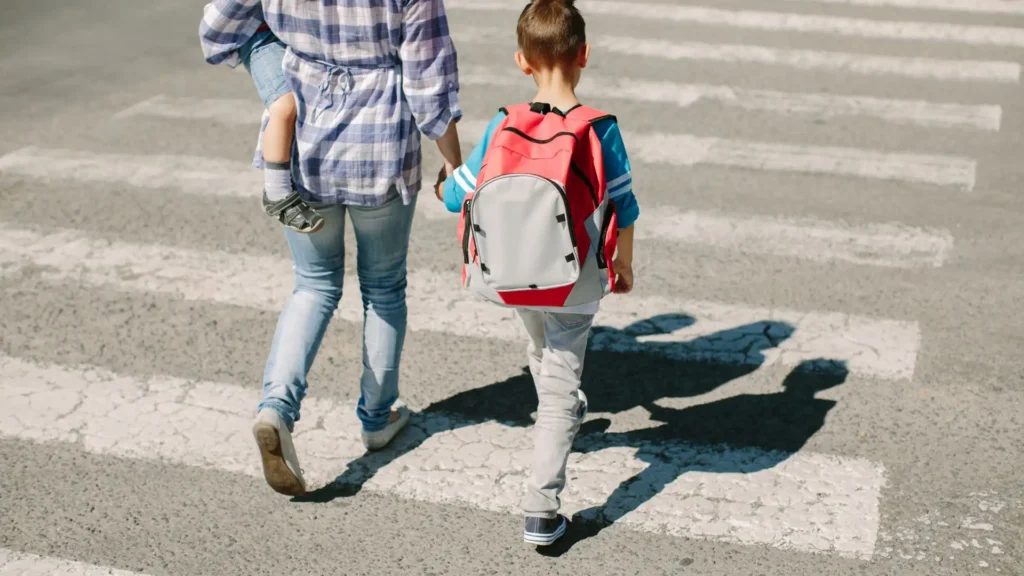Teaching road safety to autistic children is crucial for their well-being and independence. Understanding traffic rules and safe behaviors can significantly reduce accident risks. Road safety knowledge empowers children to navigate their surroundings confidently.
Yet, autistic children often face unique challenges. Their understanding of abstract concepts may be limited, making it hard to grasp the significance of road signs or the behavior of vehicles.
Sensory sensitivities can also contribute to difficulties in processing information in busy environments. A tailored approach is essential to address these challenges effectively.
Autism and Road Safety
Autistic children often face unique challenges when it comes to understanding road safety. One significant characteristic is difficulty with abstract thinking.
This can make it hard for them to comprehend concepts like traffic signals or the importance of looking both ways. They might not fully grasp the consequences of unsafe behaviors, such as running into the street without looking.
Sensory sensitivities can greatly impact their ability to navigate road environments. Bright lights, loud noises, and chaotic surroundings can be overwhelming, leading to anxiety or distraction.
This heightened sensitivity may cause them to miss vital cues, like the sound of approaching vehicles or the sight of pedestrians. These challenges require careful consideration when teaching road safety.
Tailoring lessons to accommodate their needs is essential for fostering understanding and ensuring their safety in real-world situations.
Creating a Safe Learning Environment
Establishing a calm and controlled environment is essential when teaching road safety to autistic children.
A structured setting reduces anxiety and distractions, allowing them to focus on learning. This structure can be achieved by minimizing noise and interruptions, creating a designated learning space free from chaos.
Using visuals and clear instructions enhances comprehension. Visual aids like traffic signs, diagrams, and simple step-by-step guides make abstract concepts more tangible.
Children can better grasp road safety rules when they can see them represented visually. Pair these visuals with straightforward language to reinforce understanding.
Using Visual Aids for Better Understanding
Visual aids play a crucial role in teaching road safety to autistic children. They simplify complex ideas and provide a clear representation of concepts that may be hard to grasp through words alone. These aids can enhance comprehension and retention, making lessons more engaging.
Effective visual aids can include:
- Traffic sign flashcards: Simple, colorful images of common signs help children recognize and understand their meanings.
- Illustrated step-by-step guides: These guides can outline safe crossing procedures, making the process easy to follow.
- Videos or animations: Short clips that demonstrate safe road behavior can capture attention and provide real-life context.
- Visual schedules: A daily routine that includes road safety tasks can reinforce learning through repetition.
Incorporating these visual tools creates a more effective learning experience. Children can connect the dots between visuals and real-life scenarios, ultimately improving their road safety knowledge.
Interactive Learning Methods
Engaging autistic children in road safety education can be effective through interactive learning methods. Games and simulations create a fun environment that fosters understanding. Children often respond well to hands-on experiences.
Consider these interactive activities:
- Traffic Light Game: Use colored cards to represent traffic lights. Kids can act out stopping, going, or slowing down based on the color shown.
- Obstacle Course: Set up a mini obstacle course that simulates road scenarios. Children navigate through cones or markers while practicing safe crossing techniques.
- Role-Playing Scenarios: Create real-life situations where children can act out safe behaviors, like crossing the street or waiting for the bus. This helps them internalize what they learn.
- Board Games: Use board games that incorporate road safety concepts. These games can reinforce lessons while being enjoyable.
These methods not only make learning enjoyable but also reinforce essential road safety skills. By participating in these activities, children can better retain information and feel more confident in their ability to navigate traffic safely.
Establishing Routine and Consistency
Creating a consistent approach to teaching road safety is essential. Autistic children thrive in structured environments where they know what to expect.
By using the same teaching methods regularly, children can build familiarity and confidence in their understanding of road safety.
Routine also plays a crucial role in reinforcing learning. When children engage in consistent activities, such as practicing crossing streets at the same time each day, they are more likely to remember and apply these lessons.
This repetition helps solidify their knowledge and reduces anxiety about unfamiliar situations. Establishing clear and predictable routines not only supports learning but also enhances the overall experience, making road safety education more effective and enjoyable.
Engaging Parents and Caregivers
Parents and caregivers play a vital role in reinforcing road safety lessons at home. Their involvement can significantly enhance a child’s understanding and retention of safety practices. By discussing road safety regularly, parents can create an ongoing dialogue that emphasizes its importance.
Strategies for involvement include practicing safety skills during daily routines. For instance, parents can model safe crossing at intersections or point out road signs while driving.
Using visual aids, such as posters or apps, can also be effective tools for reinforcing these concepts. Engaging in community events focused on road safety can further strengthen this connection.
When parents actively participate, children are more likely to internalize the lessons and feel confident in applying them in real-life situations.
Leveraging Technology for Road Safety Education
Technology offers a variety of tools that can enhance road safety education for autistic children. Apps and online resources provide engaging ways to learn while catering to individual needs.
Here are some useful apps and resources:
- Road Safety App: Interactive games that teach traffic signs and safe crossing techniques.
- Visual Schedule Apps: Help children understand routines and safety steps when walking near roads.
- Interactive Websites: Offer videos and quizzes on road safety topics.
- Augmented Reality Games: Simulate real-life road scenarios in a safe environment.
Utilizing these technologies can make learning more accessible and enjoyable. They cater to various learning styles, allowing children to engage at their own pace.
Visual and auditory elements help reinforce concepts, making them easier to grasp. With consistent use, technology can play a key role in solidifying road safety knowledge, ensuring that lessons stick and are applied in real-world situations.
Community Involvement in Road Safety
Community support plays a vital role in enhancing road safety education for autistic children. Schools can collaborate with local organizations to create programs that promote awareness and understanding of road safety.
These partnerships can lead to workshops, informational sessions, and even training for teachers and caregivers.
Community events, such as safety fairs and awareness campaigns, offer great opportunities for hands-on learning. These events can include demonstrations, interactive exhibits, and engaging activities that make road safety lessons memorable.
By bringing together families, educators, and local leaders, communities can foster a supportive environment that reinforces the importance of road safety for all children.
Repetition and Reinforcement
Repetition is a crucial part of learning, especially for autistic children. It helps solidify concepts and ensures that road safety rules become second nature.
By revisiting lessons regularly, children can better recall important safety information when they encounter real-life situations.
To effectively reinforce road safety lessons, consider the following strategies:
- Use daily reminders about safety rules, such as looking both ways before crossing the street.
- Incorporate road safety discussions into everyday routines, like walks or drives.
- Create engaging games that reinforce road safety, making learning fun.
- Review visual aids regularly to keep the information fresh in their minds.
- Use role-playing scenarios to practice responses to different traffic situations.
These approaches not only reinforce learning but also build confidence in applying road safety knowledge. Consistent practice helps autistic children feel more secure and aware in their surroundings.
Addressing Common Concerns and Misconceptions
Many people mistakenly believe that autistic children cannot grasp road safety concepts. This misconception often stems from a lack of understanding of autism itself.
In reality, with the right support and teaching methods, autistic children can learn and apply road safety rules effectively.
To tackle these concerns, focus on clear communication and tailored instruction. Using visual aids, role-playing, and consistent routines can help bridge the gap in understanding.
Engaging parents and caregivers in the learning process also reinforces these ideas at home. It’s essential to highlight the strengths of each child, showing that with patience and the right strategies, they can master road safety just like their peers.
FAQ Section
Can autistic children learn road safety?
Yes, with appropriate teaching methods and supports, autistic children can understand and apply road safety rules.
What teaching methods are most effective?
Utilizing visual aids, interactive games, and role-playing scenarios can significantly enhance understanding.
How important is parental involvement?
Parental involvement is crucial. Parents can reinforce lessons learned in educational settings and provide consistent reminders at home.
Are there specific challenges autistic children face?
Sensory sensitivities and difficulties with social cues can impact their comprehension of road safety. Tailoring the environment and approach can help address these challenges.
What resources are available for teaching road safety?
There are various apps and online resources designed specifically for teaching road safety to children, including those with autism.
Answering these questions can help parents and educators feel more equipped to guide autistic children in understanding road safety effectively.
Summary and Final Thoughts
Teaching road safety to autistic children involves understanding their unique needs and challenges. By creating a calm environment, using visual aids, and engaging in interactive learning, we can enhance their comprehension. Consistent routines and parental involvement further support their learning.
It’s essential to recognize that every child learns differently, and patience is key. Continued efforts in educating our children about road safety are vital. Let’s keep reinforcing these lessons to ensure their safety and build their confidence in navigating the world around them.







